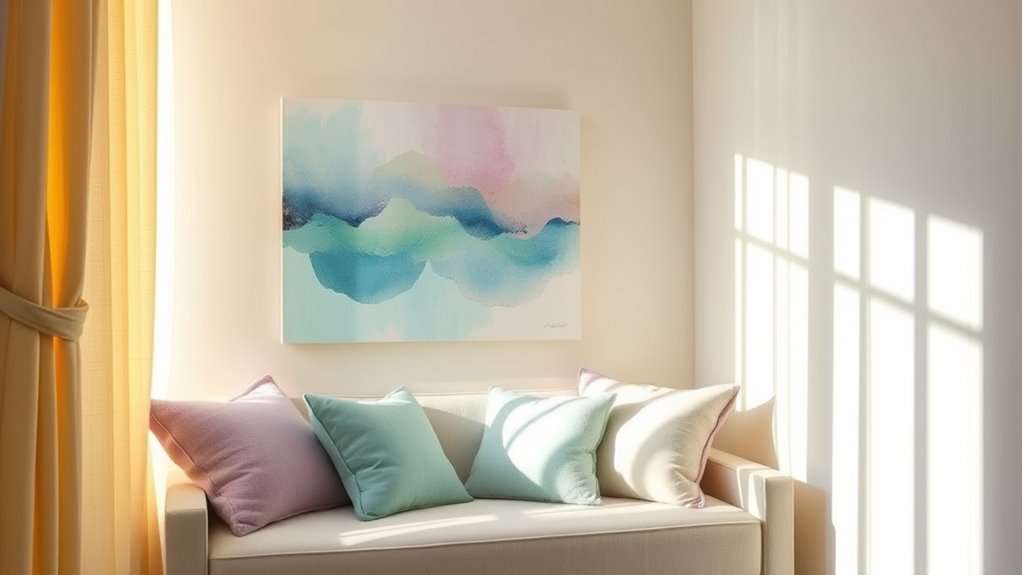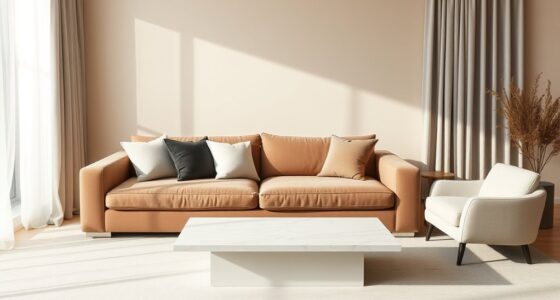Using color psychology, you can create environments that boost your well-being by choosing hues that evoke positive emotional responses. For example, incorporating calming blues and lavender can reduce stress, while bright reds and oranges can energize you when needed. Recognizing how colors influence mood allows you to tailor your spaces and wardrobe for mental refreshment and motivation. If you keep exploring, you’ll discover many ways to harness colors for your emotional health.
Key Takeaways
- Choose calming colors like blue and lavender to reduce stress and promote relaxation in your environment.
- Use vibrant hues such as orange and yellow to boost energy and motivation when needed.
- Incorporate green to foster feelings of balance, renewal, and mental refreshment.
- Be mindful of personal and cultural color associations to create emotionally supportive spaces.
- Design environments intentionally with color choices that align with desired mood and emotional well-being.

Color psychology offers a powerful way to enhance your well-being by shaping the environment around you. The colors you surround yourself with can influence your mood, behavior, and overall emotional state. Understanding color associations allows you to select hues that promote positive emotional responses, creating spaces that support your mental and emotional health. For example, blue is often linked to calmness and tranquility, making it an ideal choice for bedrooms or relaxation areas. Green, associated with nature and renewal, can foster feelings of balance and harmony, helping you feel more centered and refreshed. On the other hand, bright reds and oranges tend to evoke energy and enthusiasm but can also increase feelings of agitation if overused. Recognizing these associations helps you choose colors intentionally, aligning your environment with the emotional responses you want to cultivate.
Your emotional responses to colors are deeply personal yet rooted in common psychological patterns. When you see a soft pastel, you might feel comforted and at ease, while vibrant colors can energize or stimulate your mind. By paying attention to how different shades make you feel, you can tailor your surroundings to support your mental well-being. For instance, if you’re feeling stressed or overwhelmed, incorporating calming hues like light blue or gentle lavender into your space can help reduce anxiety and promote relaxation. Conversely, if you’re lacking motivation, adding lively yellows or oranges might boost your energy and inspire action. The key is to understand that color associations are not static; they can vary based on individual experiences and cultural influences. Still, many common emotional responses to specific colors can serve as a useful guide when designing environments that foster well-being. Additionally, understanding core principles of digital parenting can help you create balanced environments that support your child’s emotional health in a technology-driven world.
You have the power to influence your emotional landscape through mindful color choices. Whether you’re decorating your home, workspace, or even your wardrobe, consider how colors impact your feelings. Use color associations to create an environment that encourages positivity, calmness, or focus, depending on your needs. Incorporating colors that evoke the right emotional responses can help you manage stress, increase motivation, or simply enjoy a more harmonious daily life. Remember, the way you respond to colors is unique, so pay attention to how different shades affect your mood. Over time, you can develop a personalized palette that supports your emotional health and enhances your overall well-being. By consciously selecting colors based on their psychological effects, you take control of your environment and, ultimately, your emotional state.
Frequently Asked Questions
How Does Color Psychology Vary Across Different Cultures?
You might notice that color psychology varies across cultures due to cultural symbolism and color associations. In some cultures, white symbolizes purity, while in others, it signifies mourning. Red can represent luck or danger depending on where you are. These cultural differences influence how colors impact emotions and perceptions. Understanding these variations helps you appreciate diverse interpretations of colors and their effects, especially when applying color psychology across different cultural contexts.
Can Color Choices Improve Mental Health in the Workplace?
Imagine a workspace filled with calming blues and energizing yellows—these color choices leverage color symbolism to boost mental health. You can positively influence emotional responses, creating an environment that reduces stress and fosters focus. By intentionally selecting colors that evoke relaxation or motivation, you help improve well-being. Color choices truly matter; they shape how you feel and perform, making your workplace a healthier, more inspiring space.
Are There Specific Colors Recommended for Enhancing Sleep Quality?
For enhancing sleep quality, certain color associations can help create a calming sleep environment. Soft, muted shades like pale blue, lavender, and gentle green are recommended because they promote relaxation and reduce stress. You should focus on these colors in your bedroom decor, bedding, and lighting to foster a peaceful atmosphere. By choosing soothing tones, you can improve your sleep environment and support better rest each night.
How Does Individual Color Perception Affect Well-Being?
Oh, the grand mystery of individual color perception—because what sparks joy in one person might cause a yawn in another. Your emotional response to colors varies wildly, influenced by personal experiences and cultural backgrounds. So, when it comes to well-being, it’s all about tuning into your unique perception. Pick colors that lift your spirits, rather than rely on generic advice, and watch your emotional response improve.
Can Color Therapy Replace Traditional Mental Health Treatments?
You might wonder if color therapy can replace traditional mental health treatments. While color symbolism and its emotional impact can support your well-being, they shouldn’t be seen as substitutes for professional care. Color therapy can complement therapy or medication by creating a calming environment or boosting mood, but it’s not a standalone solution. Always consult mental health professionals for holistic treatment, as color influences can vary and are not universally effective.
Conclusion
As you start paying attention to the colors around you, you might notice subtle changes in your mood and energy. It’s no coincidence that certain hues seem to brighten your day or calm your mind. By intentionally choosing colors that resonate with your well-being, you create a more vibrant, balanced environment. So, next time you select your surroundings or even your wardrobe, remember—you have the power to influence your mood, often without even realizing it.









